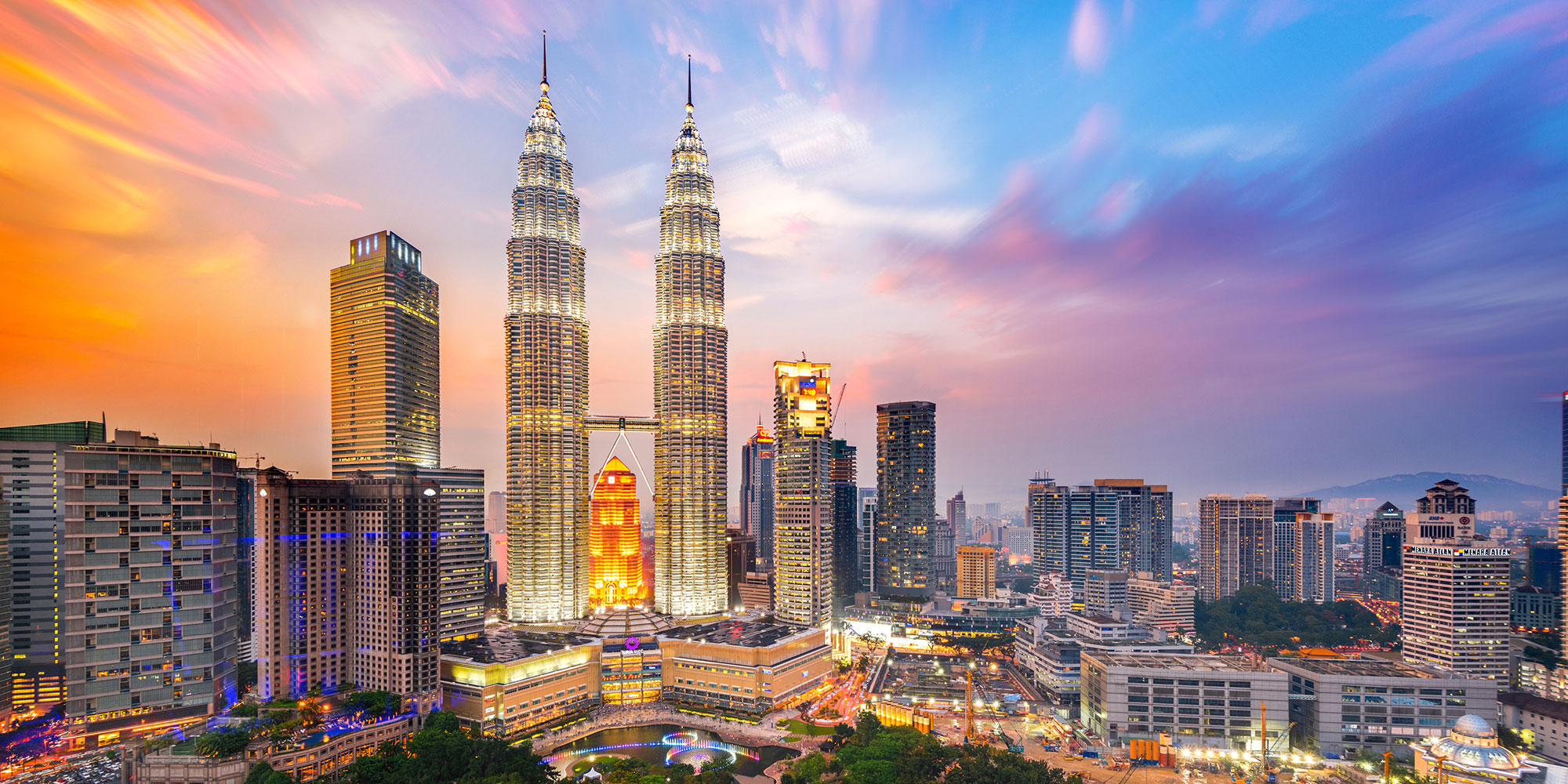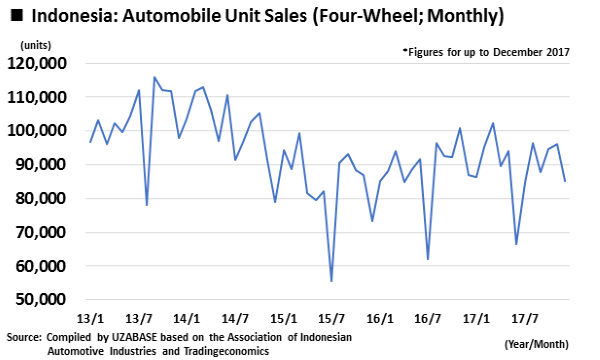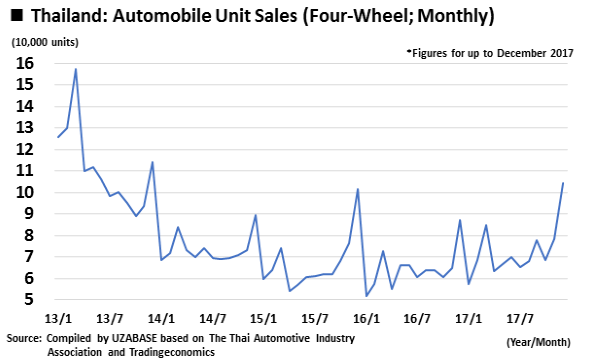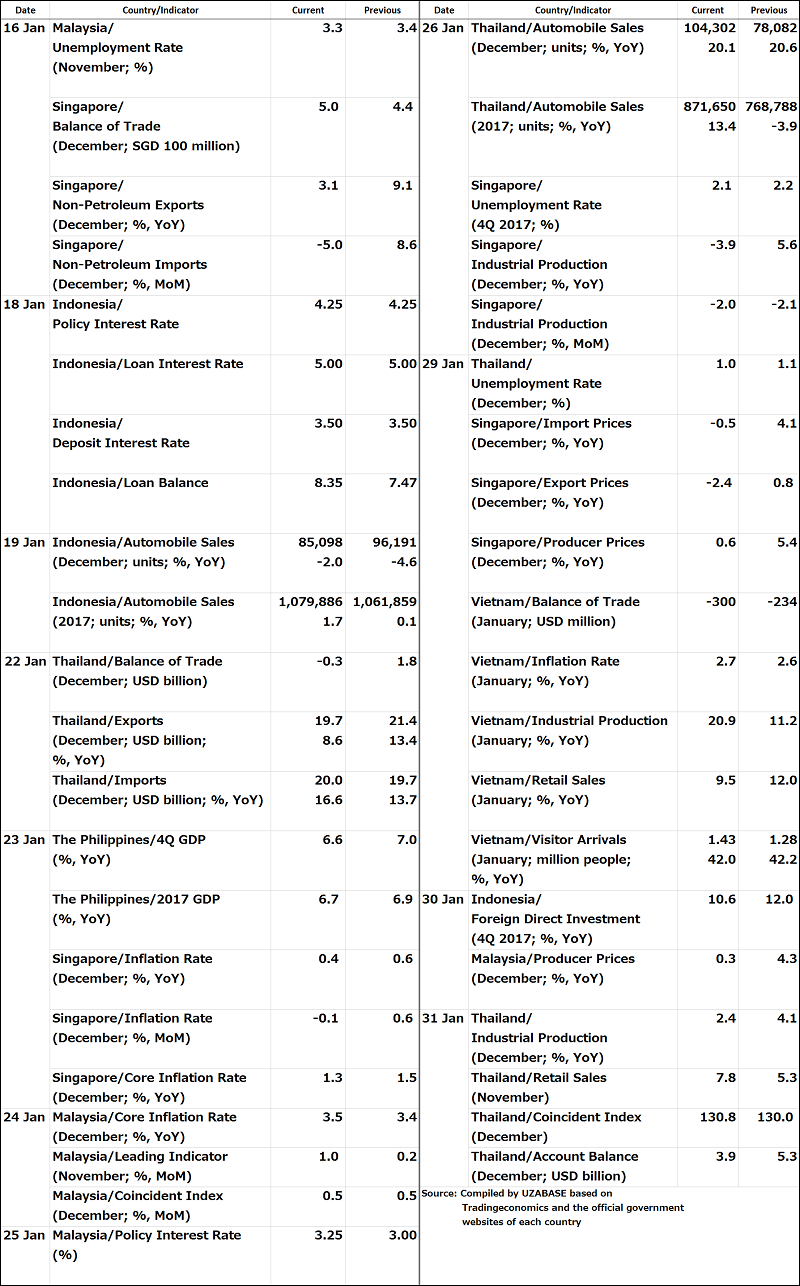Malaysia Raises Policy Interest Rate to Avoid an Overheated Economy; The Philippines Maintains Strong Growth
|
Indonesia: Additional Measures Taken to Alleviate Economy by Raising Cash-Deposit Ratio |
|
Indonesia’s Bank Indonesia (BI) held its Board of Governor’s Meeting, where it was decided that the policy interest rate of 4.25%, the deposit interest rate of 3.50%, and the loan interest rate of 5.00% will be kept as is. After lowering interest rates three consecutive times from July to September 2017, BI has decided to keep the rates as is for the fourth consecutive Board of Governor’s Meeting. |
|
To enhance liquidity, BI announced that it will lower all cash-deposit ratios that are being requested from commercial banks, a measure which BI will implement in steps in July and October 2018. Continuing from the lowering of interest rates in 2017, BI is showing its aim of further increasing liquidity and boosting the economy. |
|
|
|
In December 2017, Indonesia’s automobile sales fell by 2.0% YoY to 85,098 units, but the total for the full year rose by 1.7% to approximately 1.08 million. While the country’s automobile sales have not yet recovered to the 2014 peak of approximately 1.21 million units, they have increased for two consecutive years from the 1.06 million recorded in 2016 after falling to 1.01 million in 2015. This trend is nearly correlated with the gradual pace of economic recovery. |
|
|
|
Thailand: Recovery in Internal Demand Also Reflected in Automobile Sales |
|
Thailand’s automobile sales amounted to 104,302 units in December 2017, marking the first recovery to the 100,000-unit level since December 2015. The total figure for 2017 rose by 13.4% YoY to 871,650 units, displaying a recovery trend from the stagnant automobile market that was at the 700,000 level annually after 2014. Although the country’s economic recovery is being led by exports, it has gradually become present in internal demand as well, with the recovery in automobile sales as the likely evidence of that trend. |
|
|
|
Thailand’s Coincident Index for December was recorded at 130.8, increasing from the 130.0 recorded in November. Furthermore, the country’s retail sales were announced as up by 7.8% YoY in November, which is an acceleration from the 5.3% YoY increase in October. |
|
|
|
|
|
As explained in previous reports, the business confidence on the supply side amongst companies in Thailand had improved ahead of that on the demand side. While improvement on the demand side in areas such as household consumption had lagged behind, all indicators from around November 2017 onwards suggest that improvement is gradually being seen. |
|
No data has been presented that offers strong evidence for an optimistic view, with most views relying on information about exports, which can be easily affected by the external environment. However, the fact that internal demand, which had previously presented issues for Thailand, is showing a recovery tone can be viewed positively. Nevertheless, going forward, even more attention should be placed on whether any strong figures for data related to internal demand can be presented at the earliest stage possible. |
|
Malaysia: The BNM Moves Toward Tightening Conditions in Financial industry by Raising Interest Rate |
|
At its Monetary Policy Committee meeting on 25 January, the Central Bank of Malaysia (Bank Negara Malaysia; BNM) decided to raise the current monetary policy rate of 3.00% up by 25 basis points to 3.25%. |
|
|
|
The BNM mentioned that there has been continuous high growth for the global economy centred on OECD countries, and shared a favourable viewpoint of the domestic economy in terms of both investment and consumption. While Malaysia’s inflation rate may accelerate slightly with estimates of a rise in crude petroleum prices, its core inflation rate has relaxed. With such conditions in mind, the BNM released a statement covering its aim for normalising monetary policies, thus making a move towards tightening the financial sector. |
|
Malaysia’s economy has been growing favourably at around 5–6%, but I think that it may become slightly heated if it exceeds 6% in growth, given that the GDP per capita is close to USD 10,000. Also, I interviewed numerous Malaysian economists and came across the same opinion. An increase in household debt in Malaysia is a downside risk, so it is likely that the effects of raising the interest rate will put some restraints on individual loan activities. |
|
Making a comprehensive judgement based on these trends, it appears that the BNM is aiming for normalising the financial sector at a time when the economy has plenty of strength, and it is likely that the decision to raise the interest rate was appropriate. |
|
The Philippines: GDP for 4Q 2017 Continued on Strong Growth Trend at 6.6% |
|
On 23 January, the Philippines recorded an economic growth rate (real GDP) of 6.6% YoY for 4Q 2017, which slowed down from the 7.0% YoY for 3Q. The growth rate for the entire year was 6.7% YoY, marking a deceleration from the 6.9% YoY for 2016. |
|
However, both the 6.6% YoY for 4Q and the 6.7% YoY for the whole year were at the highest level amongst emerging nations around the world. Although each rate slowed down from previous figures, it can be said that the Philippines is maintaining a strong growth trajectory. |
|
|
|
The primary factor behind the deceleration in economic growth for this term was exports. The contribution of exports to the 2017 GDP growth was in the double digits from 1Q to 3Q, but declined to 7.7 percentage points in 4Q. However, it is at a high level in comparison to the level of contribution from exports in 2016 and earlier. While the figures for this term require consideration for export trends to come, there is a possibility of temporary effects from the Christmas holiday season in December influencing these figures. |
|
A long-term outlook based on present conditions suggests that there will likely be no changes in the gradual strengthening trend for exports, which had previously presented a major problem for the Philippine government. |
|
Singapore: Attention Required for Negative Growth in Industrial Production |
|
Singapore’s industrial production was down by 3.9% YoY in December, marking the first instance of negative growth since July 2016. There were likely effects from the Christmas holiday season and school holidays, but given the base figure of 22.4% YoY positive growth for December 2016, it is likely that industrial production is undergoing a reactive decline after displaying high growth in recent years. |
|
Singapore’s economy, which has been experiencing favourable conditions as of late, is driven by exports from the manufacturing sector. As such, although seasonal and reactionary factors can be attributed to the fall in industrial production, attention should be placed on the trends to come for the time being. |
|
Vietnam: Favourable Growth in Number of Visitor Arrivals Continues |
|
According to the regular macroeconomic statistics released at the end of each month, the number of visitor arrivals to Vietnam increased greatly by 44.0% YoY in January to 1.43 million people. The country’s industrial production also exhibited high growth at 20.9% YoY that month, displaying a favourable start to 2018. |
|
On the other hand, Vietnam’s balance of trade marked a deficit for the second consecutive month at USD 300 million. This is likely due to effects from the increasing demand and imports for consumer goods and daily necessities leading up to Tết (Vietnamese New Year) in mid-February. |
|
Key Focus in the Next Report |
|
The next report will cover 1–15 February, during which time Indonesia plans to release its 4Q and full-year economic growth rates for 2017, policy interest rate, current account balance for 4Q, and residential property price index. In addition, Malaysia plans to release its 4Q and full-year economic growth rates for 2017, and the Philippines plans to announce its policy interest rate. |
|
|











